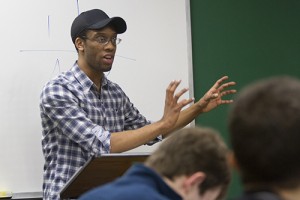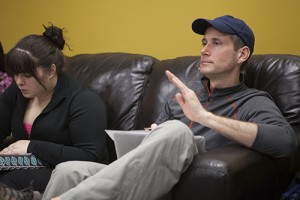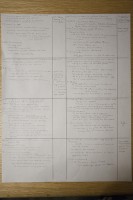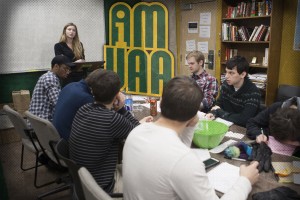Student Spotlight: Seawolf Debate Program
by Tracy Kalytiak |
Steve Johnson deftly penciled a sheet of paper into eighths, and then methodically filled each eighth with lines of diminutive hieroglyphics-each section represented a position, each line of Steve's code represented a tiny bone in the skeleton of a debate.
"It's an outline of a speech, the interrelation of ideas, proof for claims and the argumentative basis for the side assigned," said Steve, director of UAA's Seawolf Debate Program and assistant professor of Communication and Discourse Studies.
Bringing that skeleton to life with passion, intellectual precision and tactical wiliness is the task of nearly 30 people who participate in the program, for which the Seawolf Debate team provides a competitive nucleus.
Team members attack or defend sensitive questions of public policy in their competitions against other universities. This month, UAA competes in an exhibition debate against Yale University.
"No public funds should go to support competitive athletics in public education" will be the topic-or, in debate lingo, "motion"-the teams will dissect and argue at the debate, scheduled for 7:30 p.m., March 20, at the East High School Auditorium, 4025 E. Northern Lights Blvd. Brittany Bennett and Matt Stinson will represent UAA.

Seawolf debate team member Jonathon Taylor speaks during a practice debate in UAA's Administration Building. Philip Hall/University of Alaska Anchorage
Each of the four debaters will deliver a speech. Then, people in the audience can take a minute each to speak for or against the motion. Five-minute rebuttal speeches follow.
"This is a discourse, an active public discourse," Steve said of the UAA-Yale event.
Reaching out
The Seawolf Debate team doesn't just compete, however.
Its assistant coach, Amie Stanley, and members Amy Ainslie, Bexley Brown, Justin Collins, Parker Dahl, Sarah Elton, Judy Jessen, Daniel Jost, Kyle Keesecker, Matthieu Ostrander, Johanna Richter, Jonathon Taylor and Emi Webb also engage in public service, providing a way for the community and its policymakers to explore issues and develop informed opinions on them.
The team has engaged in debate about oil tax reform, and delved into topics as diverse as whether the House would repeal the Second Amendment, should the UAA campus be smoke-free, whether hate crimes warrant special punishment and if the state of Alaska should restrict the size of sugary drinks to curb obesity.
"Every single day you have to engage with people who have different ideas, deal with people who don't agree with you," said team member Amy Ainslie. "Because of debate, I'm able to look at both sides of an issue and grant legitimacy to each side."

Seawolf Debate team member Amy Ainslie, left, and coach Steve Johnson watch a practice
debate.
Philip Hall/University of Alaska Anchorage
Team members also volunteer to judge the intramural Cabin Fever Debates, hosted at UAA, and debate competitions at the middle school and high school levels, as well as helping those young students sharpen their debate skills.
"We have to really keep up on current events because we only find out the motion 15 minutes before we speak," team member Judy Jessen said. "I read the op-ed sections of a couple of newspapers, the world sections, Foreign Affairs, and I listen to the full issue of The Economist every week, using the app because I drive a lot, and that's the expectation we have as being part of the team. Then we spend one hour in office hours practicing speeches individually, and the two weekly practices. I have to say though, I've learned at least as much about debate from coaching opportunities I've been offered due to my association with the team as I have from reading and practicing on my own."
The form and flow of debate
Debates at the university level generally use the British parliamentary style, with four members representing the position of the "government" and four representing the "opposition" position. (The UAA-Yale debate uses different rules-two people will represent each university, because it is an exhibition debate.)
Each debater receives preparatory articles about the motion about 15 minutes before a tournament round begins. Speaking alternates between the two sides, which are divided into four factions.
The first two speakers define the motion of the debate, present their case, respond to arguments from the opposing side and maintain their relevance during the debate. The following two pairs of speakers introduce a case extension, respond to arguments introduced by the first pair of speakers and respond to the case extension of the opposing second-faction speakers. The final speakers must respond to both opposing factions' arguments, briefly sum up their opening faction's case and should offer a conclusion of their own faction's case extension. Speakers may offer "points of information"-POIs- to their opposition. POIs allow the first two factions to maintain their relevance during the course of the debate and the last two factions to introduce their arguments early in the debate.
When the debate concludes, a panel of judges confers and ranks the teams first through fourth, scoring teams on quality of argument, strength of supporting material, refutation of the opposing team and execution of debater duties, teamwork, presentation and strategy.
"Debate has improved my overall studies by helping learn to articulate information and become a more focused critical thinker," debate team member Parker Dahl said. "It has greatly improved my ability to see the multiple sides of an argument, which both helps me understand other people's concerns as well as how we might be able to address the concerns for both sides."
Team member Jonathon Taylor says debate appeals to him because it calls for the fair adjudication of important and relevant issues based on the facts that surround them. "As opposed to the partisan rhetoric that typically goes on when discussing political issues, debate allows us to weigh the benefits and harms of nearly any given policy, with both sides making the best, most substantive case either for or against it," he said.
"Debate is downright scary," team member Sarah Elton said. "Giving a seven-minute speech when you know what you're talking about is never enough time-but when you know nothing about the subject, it feels like eons. It forces you to confront your own ignorance of nearly everything. While the real solution is to absorb all of the information you can, I also work at reducing my pride. I try to take motions I don't know anything about as a pointer to where to research next rather than a blow to my self esteem and intelligence."
Steve's hieroglyphics on that divided sheet of paper-he refers to the sheet of notations as a "flow"-reveal his judgment of one of the numerous practice debates team members engage in. They dissect a debate, separating voice and gesture from reason and strategy, unveiling weaknesses and strengths in the armature of an argument.
"A flow has to capture 56 minutes, eight speakers, two sides," Steve said. "That's a lot of complexity. A flow is both a reflection of a round and the ideal of the direction of a round, capturing the gist of the major arguments being made, the connections between ideas."

Steve Johnson, coach of the Seawolf Debate team, created this "flow" to outline arguments made during a round of debate. Philip Hall/University of Alaska Anchorage
Crafting an argument is like learning musical scales, Steve said. Debaters move to a more advanced level when they engage opponents.
"Precious few get to the third level, comparing the relative merits of the arguments," Steve said. "Judges love it when debaters make the relative comparisons themselves."
Reaching toward an ideal
Using a flow he made during a recent practice debate, Steve pointed out which of the eight competitors constructed the best argument, and why-team member Jonathon Taylor earned Steve's top spot for that practice round.
"If a speech doesn't have numbers attached to the points, the speaker is not enumerating the basics...and from there it just cascades," Steve said, showing tiny numbers jotted neatly in Jonathon's segment of the flow. "Also, am I indenting things. The indentations reflect relationships between ideas and these relationships are ultimately what I'm evaluating."
Guiding students toward the Platonic ideal of a perfectly assembled argument is Steve's mission.
"There's a joy in clarity of thinking," he said. "It's joyous, satisfying, comforting what you feel when you watch a debate flow from abstract ideas to physical form."
Written by Tracy Kalytiak, UAA Office of University Advancement.
 "Student Spotlight: Seawolf Debate Program" is licensed under a Creative Commons Attribution-NonCommercial 4.0 International License.
"Student Spotlight: Seawolf Debate Program" is licensed under a Creative Commons Attribution-NonCommercial 4.0 International License.















